Create view (filtering and sorting)
You use a view when it's not practical to go through the project document by document. With a view, you can look at segments that have something special in common. Some examples:
- Repeated segments
- Segments that contain certain words or expressions
- Segments that were not translated
- Segments that were confirmed by a translator
- Segments that contain certain tags
You can set many more conditions to filter the segments in your project.
When memoQ creates a view, it pulls together all segments from all documents, and filters them by the conditions you set. The view appears on the Views tab.
You can open a view for translation just like a normal document. You edit the translation in the same translation editor.
A view does not copy segments from the documents of the project. It really is a view only. Every segment in a view comes from a document. When you change a segment, the change is saved to the original document, too.
In a project, the view appears in the Translations pane of Project home, but on the Views tab. It isn't mixed up with the documents.
For example: You want to translate repeated segments separately. You create a view of the repeated segments, and translate them. Then the translations of the repeated segments appear in the documents, too. Then you can assign different translators to translate the rest.
Local projects only: You can't create views in online projects. If you need a view in an online project: Create a local project. Create the view. Assign users to the view. Publish the project. In the Publish project wizard, choose to publish views that are assigned. Or, choose to publish views only. Caution: In the online project, the views appear as regular documents. The original documents aren't updated automatically. To update the original documents: Download the view in a bilingual document, and update the view in the original local project.
How to get here
- Open a local project. In Project home, choose Translations.
- On the Documents tab, select one or more documents. memoQ uses the segments from the selected documents.
- On the Documents ribbon, click Create view. The Create view window appears, in a simplified form.
- At the bottom of the window, click Advanced options.
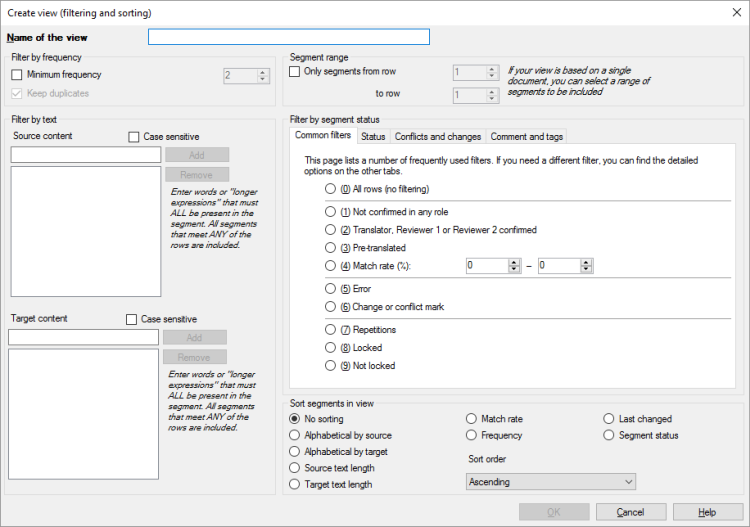
What can you do?
Before anything else, give the view a name: Type a name in the Name of the view text box.
- Under Filter by frequency, check the Minimum frequency check box.
- To get segments that are repeated very frequently: Set a number in the number box next to the Minimum frequency check box. For example, if you set it to 3: memoQ gets segments that repeat 3 or more times.
If the view will be translated in this local project: Check the Keep duplicates check box. memoQ will get every occurrence of each repeated segment. When you translate a segment in the view, it will be propagated to the other occurrences. All documents that contain the segment are updated automatically.
If the view will be translated in an online project: Clear the Keep duplicates check box. For every repeated segment, memoQ will get the first occurrence only. In the online project, the working translation memory is updated. This makes sure that every repeated segment will get a 100% match with the 'official' translation.
- To check certain terms in the source text: List them on the Source content list.
For example, you would need to check the translation of the term 'translation memory' into Hungarian. The term has two competing translations, depending on the toolmaker.
Type an expression in the text box below Source content. If you expect the same capitalization: Check the Case sensitive check box. Click Add.
To remove an expression from the list: Click it. Then click Remove.
- To check certain terms in the target text: List them on the Target content list.
For example, you translate into English, and you would need to check the term 'term base'. Some write it in two words, others in one. (You can do this using Find and Replace, too.)
Type an expression in the text box below Source content. If you expect the same capitalization: Check the Case sensitive check box. Click Add.
To remove an expression from the list: Click it. Then click Remove.
You can list terms on both lists: Then memoQ will get segments that contain one of the terms from the Source content list, or one of the terms from the Target content list.
- Under Filter by segment status, click the Common filters tab.
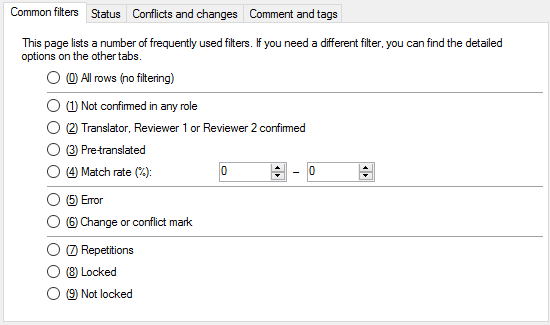
- Click the (1) Not confirmed in any role radio button.
Here are all the options you can choose from:
- All rows (no filtering) radio button: Select this if you do not want to filter the segments for their status.
- Not confirmed in any role radio button: Jumps to segments that have any status but not confirmed by translator, reviewer 1 or reviewer 2.
- Translator confirmed, Reviewer 1 confirmed, or Reviewer 2 confirmed radio button: Jumps to segments that are Translator confirmed, Reviewer 1 confirmed or Reviewer 2 confirmed.
- Pre-translated radio button: Displays segments that were filled in through pre-translation and were not changed since.
- Match rate radio button: Displays segments that were originally pre-translated or filled in with a certain match rate. (Since then, they may have been edited or confirmed, but the match rate is still there.) Type two numbers in the boxes next to the radio button. For example, if you type 80 to 90, memoQ displays segments with matches between 80 and 90 percent.
- Error radio button: Displays segments that have errors that prevent the document from being exported.
- Change or conflict mark radio button: Displays segments that contain marks that indicate that the segment was changed by another user, or that the segment was modified by multiple users at the same time. Such marks appear when more than one users work on a document in an online project.
- Repetitions radio button: Displays segments that are marked as repetitions. This setting is different from the settings in the Filter by frequency section.
- Non-repetitions radio button: Displays segments that are not marked as repetitions.
- Locked radio button: Displays locked segments.
- Not locked radio button: Displays segments that are not locked.
- Under Filter by segment status, click the Status tab.
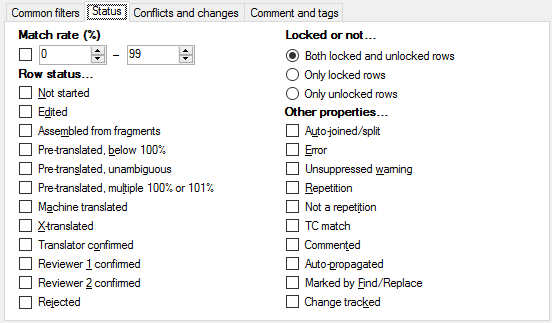
- Check the Edited and the Error check boxes.
Here are all the options you can use:
- Match rate (%): Displays every segment that was originally pre-translated or filled in with a certain match rate. (Since then, they may have been edited or confirmed, but the match rate is still there.) Check the check box before the two number boxes. Fill in the number boxes with two numbers. For example, if you enter 80 and 90, memoQ will give you segments that were originally pre-translated or filled in with a match rate between 80 and 90 percent.
- Row status:
- Not started: Check this to see every empty – not started – segments. This is the default setting.
- Edited: Check this to see every segment that was edited but was not confirmed.
- Assembled from fragments: Check this to see every segment put together from terms or other partial matches (fragments).
- Pre-translated, below 100%: Check this to see every segment that is below a100% match and comes from pre-translation.
- Pre-translated, unambiguous match: Check this to see every segment that has an unambiguous matchrate and comes from pre-translation.
- Pre-translated, multiple 100% or 101%: Check this to see every segment that is a 100% or 101% match and comes from pre-translation.
- Machine translated: Check this to see every machine translated segment
- X-translated: Check this to see every X-translated segment
- Translator confirmed: Check this to see every confirmed segment.
- Reviewer 1 confirmed: Check this to see every segment that was confirmed by the Reviewer 1 role.
- Reviewer 2 confirmed: Check this to see every proofread segment.
- Rejected: Check this to see all rejected segments.
- Locked or not:
- Both locked and unlocked rows: Includes all rows in the view, regardless of their locked or unlocked status.
- Only locked rows: Includes only the locked – not translatable – segments.
- Only unlocked rows: Includes only the not locked – translatable – segments.
- Other properties:
- Auto-joined/split: Check this to see auto-joined/split segments.
- Error: Check this to see errors that prevent the document from being exported.
- Unsuppressed warning: Check this to see warnings that were not set to 'ignore'. Warnings do not prevent the document from being exported.
- Repetition: Check this to see segments that is a repetition of another segment within the text.
- Not a repetition: Check this to see segments that are not repetitions of another segment within the text.
- Track Changes match: Check this to see every segment that has a track changes match.
- Commented: Check this to see every segment that contains a comment.
- Auto-propagated: Check this to see every segment that came from auto-propagation .
- Marked by Find/Replace: Check this to see every segment that was marked as a Find and replace hit.
- Change-tracked segment: Check this to see every segment where track changes were used and the original target segment was modified.
If you use a combination of settings from the three groups, they must be matched together. For example, if the settings are the following:
- Only unlocked rows radio button selected, and
- Edited and Translator confirmed check boxes checked, and
- Unsuppressed warning and Commented check boxes checked:
memoQ gets segments that are not locked and are either edited or confirmed, and have an unsuppressed warning or a comment, or both.
You can use this in a checkout of an online project. Or, in a local project where documents were updated from bilingual files.
- Under Filter by segment status, click the Conflicts and changes tab.
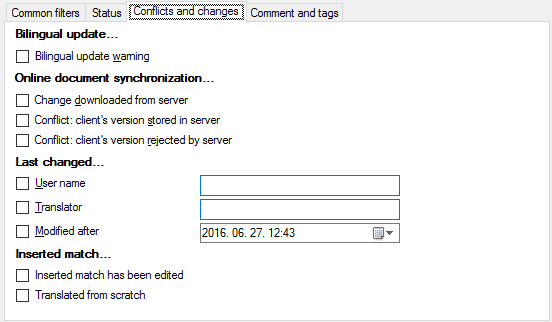
- Check the Change downloaded from server check box.
Here are all the options you can use:
- Bilingual update section:
- Bilingual update warning check box: Gets segments that were modified when the document was updated from a bilingual file.
- Online document synchronization section:
- Change downloaded from server check box: Works in a checkout of an online project. Gets segments that were modified by another user, and were downloaded from the server.
- Conflict: client's version stored in server check box: Works in a checkout of an online project. Gets segments that were in conflict with another change from someone else, and your change was saved to the memoQ server.
- Conflict: client's version rejected by server check box: Works in a checkout of an online project. Gets segments that were in conflict with another change from someone else, and your change was rejected by the server. This means that the other user's version "won".
- Last changed section:
- User name text box: Type a user name here. Gets segments that were last modified by the user by that name. The name doesn't have to be one from the memoQ server. User names in documents may come from various other places, too.
- Translator text box: Type a user name here. Gets segments that were translated by the user by that name. The name doesn't have to be one from the memoQ server. User names in documents may come from various other places, too.
You can choose from the actual user names that are there in the document: Before you do that, click Get user names.
- Modified after date selector: Select a date and time here. Gets segments that were modified on this date and at this hour, or later.
- Inserted match section:
- Inserted match has been edited: Gets segments where a match was inserted, but the current translation is different from that match.
- Translated from scratch: Gets segments where a match was not inserted.
- Under Filter by segment status, click the Comment and tags tab.

- To find segments with a certain comment: Type an expression in the Comment contains text box.
Here are all the options you can use:
- Comment contains text box: Type an expression here. memoQ gets segments that have at least one comment containing the expression. You can type several expressions, too, separated with a comma (,). memoQ gets segments where one of the expressions is in one of the comments.
- Row has active language quality error check box: Gets segments where the reviewer added an LQA error.
- Source has memoQ {tag} check box: Gets segments where the source text includes an uninterpreted formatting tag.
- Target has memoQ {tag} check box: Gets segments where the target text includes an uninterpreted formatting tag.
- Source has inline tag check box and text box: Gets segments where the source text contains inline tags with a specific text. Type the text in the text box next to the check box. You can type several expressions, too, separated with a comma (,). memoQ gets segments where one of the expressions is in one of the inline tags on the source side.
- Target has inline tag check box and text box: Gets segments where the target text contains inline tags with a specific text. Type the text in the text box next to the check box. You can type several expressions, too, separated with a comma (,). memoQ gets segments where one of the expressions is in one of the inline tags on the target side.
When you filter for inline tags, you can also check their attributes. In the expressions you type, you can specify a tag that has an attribute with a specific value. To check an attribute of a tag, type the name of the tag, then a > sign, and then the name of the attribute. If you also want to check the value of the attribute, type one more > sign, and then the value. Here are your options:
- tagname: Finds all tags that have tagname occurring in their names. Example: ingredient will find all of these:
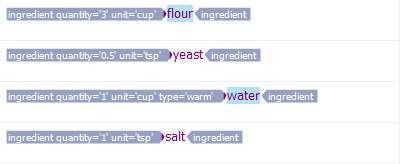
- tagname>attributename: Finds all tags that have a specific attribute, regardless of its value. Example: ingredient>type will find this:

- tagname>attributename>value: Finds all tags that have a specific attribute with a specific value. Example: ingredient>unit>cup will find these two:


- You can omit the name of the tag or the attribute. Thus you can find inline tags where the tag name is different, but they have the same attribute. Or, you can look for inline tags where both the tag name and the attribute name are different, but they share a common value. To find the above two segments, you can type this: >unit>cup, or this: >>cup.
- If the value contains spaces or commas, write them between quotes. Example: >author>name>"Technical Writer".
- Anything you write in the value part without quotes or with double quotes will be found in the text of the value. (In other words: memoQ doesn't check for a full match.) For example, ingredient>unit>c will find this:

- If you want an exact match, write the value between single quotes: ingredient>unit>'cup'.
- To write a double quote inside a value name, type it with a back slash: \". To write a single quote (apostrophe) inside a value name, type it (again) with a back slash: \'.
You can write relatively complex expressions here. memoQ warns you if your input has wrong syntax. The background of the text box turns light red if there is something wrong:

If a document is too large, you can divide it between translators: Extract different parts of the document into separate views.
In the Documents tab of Project home, select just one document. Then start creating a view.
The view will contain segments from a segment to another. You type the number of the first and the last segment.
Before you create the view: Open the document for translation, and check the numbers of the segments.
- Under Segment range section, check the Only segments from row check box.
- Type the number of the first segment in the first number box.
- Type the number of the last segment in the number box.
The view will include the first and the last segment, too.
Normally, memoQ includes the segments in the view in the order they occur in the documents.
To sort them differently: Choose an option under Sort segments in view at the bottom of the window.
- No sorting: Segments appear in the order they orccur in the documents.
- Alphabetical by source: Sorts segments in alphabetical order of the source-language cells.
- Alphabetical by target: Sort segments in alphabetical order of target-language cells.
- Source text length: Sorts segments by length of the source text.
- Target text length: Sorts segments by length of the translation.
- Match rate: Sorts segments by the match rate of the source language entries. Makes sense in segments that were originally pre-translated. All other segments have a match rate of 0%.
- Frequency: Sorts segments by the number of times the source text is repeated throughout the view.
- Last changed: Sorts segments by the date they were last changed.
- Segment status: Sorts segments by segment status. The normal ascending order is this: Not started, Pre-translated, Edited, Translator confirmed, Reviewer 1 confirmed, Reviewer 2 confirmed.
- Sort order drop-down box: Choose Ascending or Descending.
- Ascending: Sorts segments in ascending order: From A to Z; from shortest to longest; from lower to higher.
- Descending: Sorts segments in descending order: From Z to A; from longest to shortest; from higher to lower.
A view is static: memoQ checks the filtering conditions only when it creates the view. If the status of the segment changes later, it won't go away from the view. Let's say you create a view of edited segments. After the view is created, one of these segments is confirmed. It's no longer Edited, but because memoQ doesn't check the status after the view is created, it stays in the view.
When you finish
To create the view, and open the Views tab in Translations: Click OK.
To return to the Documents tab of Translations, and not create the view: Click Cancel.
Possible next steps
- Return to the Documents tab, and create yet another view.
- Open the view for translation, and go through it in the translation editor.
- Publish the project to an online project, and assign work to translators and reviewers.